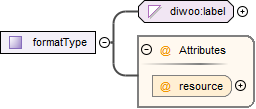Complex Type diwoo:formatType
- Diagram
-

- Gebruikt door
-
- Element
- Attributen
-
-
- Type
- formatlijst.dita#formatlijst
- Verplicht
- nee
- Definitie
- de URI voor het formaat
-
Attribute diwoo:formatType / @resource
- Documentatie
- de URI voor het formaat
- Eigenschappen
-
- content:
- simple
- Waarden
-
base-uri:
http://publications.europa.eu/resource/authority/file-type/BMP-
Bitmap Image File
The bitmap image (BMP) or device independent bitmap (DIB) is a raster graphics image file format used to store bitmap digital images, independently of the display device.
BWF-
BWF
BWF – Broadcast Wave Format – is an extension of the Microsoft WAV audio format and is the recording format of most file-based non-linear digital recorders used for motion picture, radio and television production. The purpose of this file format is the addition of metadata to facilitate the seamless exchange of sound data between different computer platforms and applications.
CSV-
CSV
CSV – comma-separated values – files store tabular data (numbers and text) in plain text. Each line of the file is a data record. Each record consists of one or more fields, separated by commas.
GIF-
GIF
GIF – Graphics Interchange Format – is a bitmap image format that was developed by a team at the bulletin board service (BBS) provider CompuServe.
GML-
GML
GML – Geography Markup Language – is the XML grammar defined by the Open Geospatial Consortium (OGC) to express geographical features. GML serves as a modeling language for geographic systems as well as an open interchange format for geographic transactions on the Internet.
JPEG-
JPEG
JPEG – Joint Photographic Experts Group – is a commonly used method of lossy compression for digital images, particularly for those images produced by digital photography. The degree of compression can be adjusted, allowing a selectable tradeoff between storage size and image quality.
MPEG2-
MPEG-2
MPEG-2 – Moving Picture Experts Group – is a standard for the generic coding of moving pictures and associated audio information. It describes a combination of lossy video compression and lossy audio data compression methods, which permit storage and transmission of movies using currently available storage media and transmission bandwidth.
MPEG4-
MPEG-4
MPEG-4 – Moving Picture Experts Group – is a method of defining compression of audio and visual (AV) digital data. It was designated a standard for a group of audio and video coding formats and related technology.
ODT-
ODT
ODT is the word processing file format of OpenDocument, an open standard for electronic documents.
PDF-
PDF
PDF – Portable Document Format – is a file format developed to present documents, including text formatting and images, in a manner independent of application software, hardware and operating systems. Based on the PostScript language, each PDF file encapsulates a complete description of a fixed-layout flat document, including the text, fonts, vector graphics, raster images and other information needed to display it. PDF was standardized as an open format and does not require any royalties for its implementation.
PNG-
PNG
PNG – Portable Network Graphics – is a raster graphics file format that supports lossless data compression. PNG was created as an improved, non-patented replacement for Graphics Interchange Format (GIF), and is the most widely used lossless image compression format on the Internet.
RTF-
RTF
RTF – Rich Text Format – is a proprietary document file format developed for cross-platform document interchange with Microsoft products.
SVG-
SVG
Open standard for two-dimensional vector graphics.
TIFF-
TIFF
TIFF – Tagged Image File Format – is a computer file format for storing raster graphics images, popular among graphic artists, the publishing industry and photographers. TIFF is widely supported by scanning, faxing, word processing, optical character recognition, image manipulation, desktop publishing and page-layout applications. The format was created by Aldus Corporation for use in desktop publishing.
TXT-
Plain text
Plain text is the data (e.g. file contents) that represent only characters of readable material but not its graphical representation nor other objects. It may also include a limited number of characters that control simple arrangement of text, such as line breaks or tabulation characters. Plain text is different from formatted text, where style information is included, and from ‘binary files’ in which some portions must be interpreted as binary objects (encoded integers, real numbers, images, etc.).
- Gebruikt door
-
